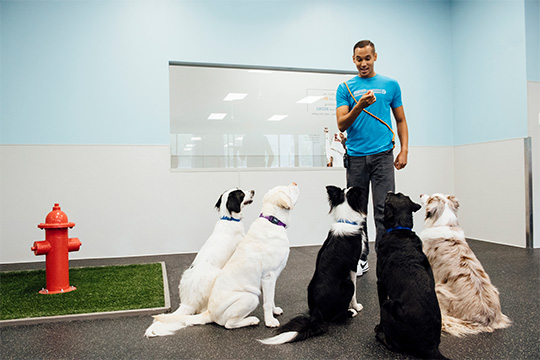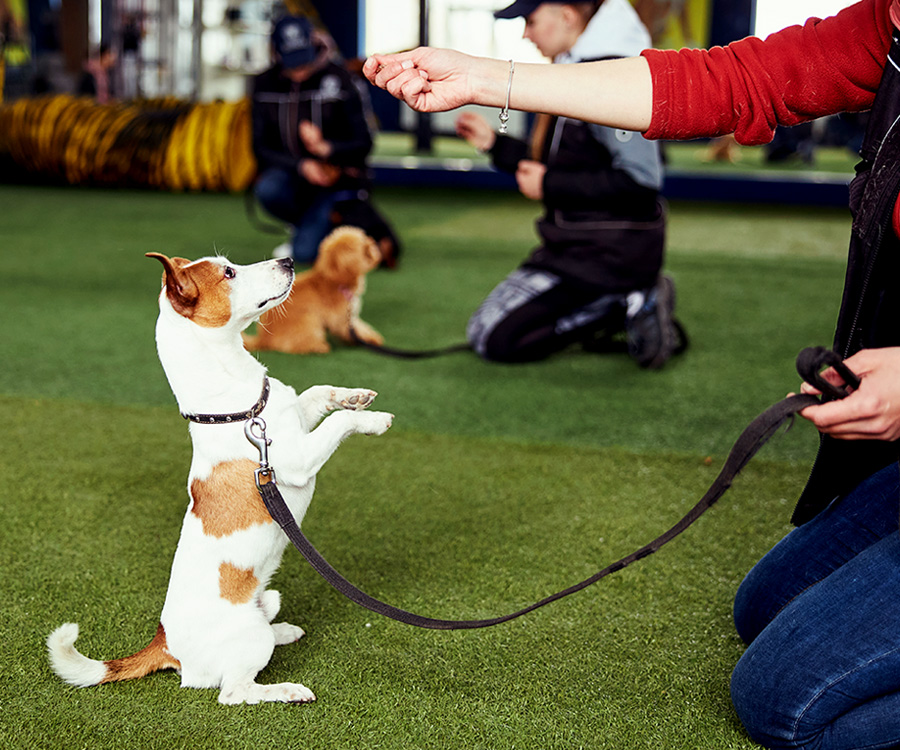How Professional Dog Training Can Enhance Your Dog’s Skills and Behavior
Beginner's Overview to Effective Canine Training in your home
Successfully training a pet in your home calls for a nuanced understanding of canine habits and efficient interaction approaches. Establishing clear training objectives, utilizing top notch benefits, and preserving uniformity across member of the family are crucial components. Moreover, integrating training right into daily regimens can enhance both involvement and retention. Lots of beginner instructors encounter obstacles that might hinder development. To browse these intricacies successfully, it's important to explore several essential aspects that can transform your strategy and lead to a harmonious partnership with your family pet. What fundamental principles should every novice grip to guarantee success?
Comprehending Pet Actions
Recognizing pet dog habits is necessary for efficient training and promoting a harmonious partnership between people and their canine companions. Dogs communicate largely via body movement, vocalizations, and facial expressions, making it essential for owners to analyze these signals precisely. Acknowledging behaviors such as tail wagging, grumbling, or shrinking can give understandings into a canine's emotional state and objectives.

Typical behavior issues, such as aggression, anxiety, or too much barking, often come from misconceptions or unmet requirements. Observing and dealing with these issues quickly can stop rise and ensure a favorable training experience. By cultivating a deep understanding of canine actions, owners can customize their training approaches to fit their canine buddies, inevitably causing a mannerly and satisfied family pet.
Crucial Educating Tools
A fully equipped training space can significantly boost the efficiency of canine training in your home. Necessary training devices guarantee that both the pet dog and the trainer can participate in efficient sessions that foster knowing and bonding.

Purchasing a sturdy leash and a comfortable, well-fitting collar or harness is important for safety and security and control. These tools aid establish limits and guarantee the dog remains secure throughout training. Furthermore, a marked training area, without interruptions, aids concentration for both the fitness instructor and the pet.
Educating aids such as training pads, cones, or dexterity equipment can also enhance the experience by introducing selection and difficulties. Having a notebook or digital application for tracking progress can be indispensable, permitting you to keep in mind successes and areas for enhancement. Utilizing these important devices will produce a favorable training atmosphere and lay the structure for reliable discovering.
Developing a Training Regimen
Developing a constant training routine is important for effective pet dog training in the house. A well-structured regular not just aids in strengthening preferred habits but likewise gives your dog with a feeling of safety and predictability. To develop a reliable training regular, begin by identifying specific training objectives, such as standard commands, leash strolling, or house-training.
Pick a marked time daily for training sessions, preferably when your pet is sharp and receptive. Procedure should be short, about 5 to 15 mins, to preserve emphasis and prevent fatigue. Uniformity in timing and environment will certainly boost your dog's discovering experience.
Include training right into everyday activities to enhance abilities. For instance, method commands during walks or mealtime, which integrates learning into natural regimens. Furthermore, continue to be flexible and readjust the routine as required, accommodating your pet dog's energy degrees and mood.
Favorable Support Techniques
Positive reinforcement methods are basic to efficient canine training, promoting preferred habits with rewards instead of punishment. This technique uses favorable stimulations, such as deals with, praise, or play, to urge canines to duplicate certain activities. The keystone of this approach is timing; incentives must be offered promptly adhering to the preferred actions to develop a clear organization.
When carrying out favorable reinforcement, it is necessary to select benefits that are motivating for your canine. High-value treats, such as little pieces of hen or cheese, can be especially reliable during training sessions. Furthermore, differing the rewards can preserve your pet dog's passion and excitement.
Begin with easy commands, like "sit" or "stay," and progressively progress to extra intricate tasks. Consistency is key; ensure that all family participants utilize the exact same commands and incentive systems to stay clear of complication.
Additionally, it is crucial to continue to be patient and avoid frustration. special info Dogs, like human beings, discover at their own pace. By promoting a helpful training atmosphere via favorable support, you can enhance your dog's understanding experience while strengthening the bond between you and your furry companion, laying the foundation for successful training outcomes.
Typical Training Challenges
While training a pet at home can be a rewarding experience, it commonly features a set of common obstacles that can examine both persistence and uniformity. One prevalent problem is disturbance. Pets may end up being conveniently sidetracked by sounds, activities, or perhaps aromas in their setting, making it challenging to keep their focus throughout training sessions.
One more challenge is inconsistency in commands and reinforcement. It can puzzle the pet dog and impede progression if family members use different cues or rewards. Developing a unified strategy is important for effective interaction.
In addition, pets can experience stress or anxiety, especially if they do not understand what is anticipated of them. This can result in unwanted habits, such as eating or barking.
Ultimately, the timing of reinforcement is critical (Dog training). Postponed rewards can diminish the effectiveness of favorable support, as canines may fall short to connect the habits with the reward
Conquering these difficulties resource requires dedication, clear communication, and a structured training plan. Recognizing and resolving these usual barriers will pave the means for a more enjoyable and successful training experience at home.
Final Thought
In verdict, successful canine training at home necessitates an extensive understanding of canine behavior and reliable communication strategies. By establishing clear training objectives and using high-quality treats alongside positive reinforcement, the training process ends up being extra rewarding for both the pet and the instructor.
Developing a regular training regimen is crucial for reliable canine training at home.Positive reinforcement methods are fundamental to effective canine training, promoting desired actions through rewards rather than punishment click over here now (Dog training). By cultivating an encouraging training setting via favorable support, you can boost your pet dog's discovering experience while reinforcing the bond in between you and your fuzzy friend, laying the foundation for effective training results
In final thought, successful pet training at home demands a comprehensive understanding of canine behavior and reliable communication strategies. By developing clear training goals and making use of high-quality deals with together with favorable support, the training process becomes more gratifying for both the canine and the trainer.